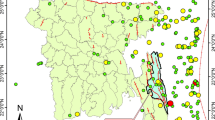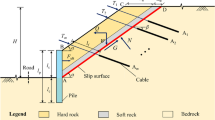Abstract
Geotechnical and earthquake engineering put a great deal of emphasis on slope stability studies under dynamic loads. The input ground motions and the dynamic characteristics of the soil medium greatly influence how slopes respond to seismic waves. The current work investigated the Seismic behavior of a bamboo grid reinforced slope, geogrid reinforced slope, and unreinforced slope, which utilized 2D numerical analyses using the finite element program MIDAS GTS NX (340) 2023 v1.1. For this investigation, Three ground motion records, such as 1940, El Centro Site, 270 Deg, 1971 San Fernando Down, and 1985, Mexico City, Station 1, 180 Deg, are used in the nonlinear time history analysis of the slope. The comparison of lateral displacement, settlement, and developed acceleration results for different slopes.The face of the slope is a more vulnerable zone due to the 1940 El Centro Site, 270 Deg (ground motion − 1), whereas the base of the slope is more vulnerable due to the 1971 San Fernando Down (Ground motion − 2) and the crest of the slope is more vulnerable due to Mexico City, Station 1, 180 Deg (Ground motion − 3). Hence, the reinforcement is more effective for ground motion − 1 and less effective for ground motions 2 and 3. Maximum variation of acceleration, lateral displacement, and settlement are seen up to 5 s in all cases of ground motion. Hence, up to 5 s is crucial for all ground motion. The bamboo grid reinforced slope performed well compared to the geogrid reinforced slope and unreinforced slope regarding lateral displacement and settlement for ground motion − 1.
















Similar content being viewed by others
Data Availability
The datasets generated during and/or analyzed during the current study are available from the corresponding author upon reasonable request.
References
Al-Barqawi M, Aqel R, Wayne M, Titi H, Elhajjar R (2021) Polymer geogrids: a review of material, design and structure relationships. Materials 14(16):4745
Al-Defae AH, Caucis K, Knappett JA (2013) Aftershocks and the whole-life seismic performance of granular slopes. Géotechnique 63(14):1230–1244
Bathurst RJ (1997) Review of seismic design, analysis and performance of geosynthetic reinforced walls, slopes and embankments, Keynote Lecture. Proc. of the International Symposium on Earth Reinforcement, 2, 887–918
Bathurst RJ, Cai Z (1995) Pseudo-static seismic analysis of geosynthetic-reinforced segmental retaining walls. Geosynthetics Int 2(5):787–830
Bathurst RJ, Hatami K (1998) Seismic response analysis of a geosynthetic-reinforced soil retaining wall. Geosynthetics Int 5(1–2):127–166
Bonaparte R (1986) Seismic design of slopes reinforced with geogrids and geotextiles. Proc. of Third Int. Conf. on Geotextiles, Vienna, 273–278
Cami B, Payan M (2023), April Probabilistic Analysis of a Slope Using RLEM and Cross-Correlated Conditional Random Field. In Proceedings of the TMIC 2022 Slope Stability Conference (TMIC 2022) (Vol. 13, p. 71). Springer Nature
Collin JG, Chouery-Curtis VE, Berg RR (1992) Field observations of reinforced soil structures under seismic loading. International Symposium on Earth Reinforcement Practice, 223–228
Dastpak P, Jamshidi Chenari R, Cami B, Javankhoshdel S (2021) Noncircular deterministic and stochastic slope stability analyses and design of simple geosynthetic-reinforced soil slopes. Int J Geomech 21(9):04021155
Elia G, Amorosi A, Chan AHC, Kavvadas MJ (2011) Fully coupled dynamic analysis of an earth dam. Géotechnique 61(7):549–563
Fatehi M, Hosseinpour I, Chenari J, Payan R, M., Javankhoshdel S (2023) Deterministic Seismic Stability Analysis of Reinforced Slopes using Pseudo-static Approach. Iran J Sci Technol Trans Civil Eng 47(2):1025–1040
Hegde A, Das T (2019) Finite element-based probabilistic stability analysis of rock-fill tailing dam considering regional seismicity. Innovative Infrastructure Solutions 4:1–14
Hegde A, Sitharam TG (2017) Experiment and 3D-numerical studies on soft clay bed reinforced with different types of cellular confinement systems. Transp Geotechnics 10:73–84
Hesari SA, Javankhoshdel S, Payan M, Chenari RJ (2021) Pseudo-static internal stability analysis of geosynthetic-reinforced earth slopes using horizontal slices method. Geomechan Geoeng 17(5):1417–1442 https://doi.org/10.1080/17486025.2021.1940316
Hesari S, Javankhoshdel S, Payan M, Chenari RJ (2022) Pseudo-static internal stability analysis of geosynthetic-reinforced earth slopes using horizontal slices method. Geomech Geoeng 17(5):1417–1442
Hung C, Lin G-W, Syu H-S, Chen C-W, Yen H-Y (2018) Analysis of the Aso-bridge landslide during the 2016 Kumamoto earthquakes in Japan. Bull Eng Geol Environ 77:1439–1449
Jaiswal S, Chauhan VB (2022) Influence of secondary reinforcement layers to enhance the stability of steep soil slope under earthquake loading. Arab J Geosci 15(11):1095
Javankhoshdel S, Cami B, Chenari RJ, Dastpak P (2021) Probabilistic analysis of slopes with linearly increasing undrained shear strength using RLEM approach. Transp Infrastructure Geotechnology 8:114–141
Javankhoshdel S, Ma T, Cami B, Azami A and Yacoub T (2023) 2D and 3D probabilistic slope stability analysis of a levee with relief wells. Geo-Congress
** Y, Kim H, Kim D, Lee Y, Kim H (2021) Seismic response of flat ground and slope models through 1 g shaking table tests and Numerical Analysis. Appl Sci 11(4):1875
Koga Y, Washida S (1992) Earthquake resistant design method of geotextile reinforced embankments. International Symposium on Earth Reinforcement Practice, 255–259
Latha GM, Garaga A (2010) Seismic stability analysis of a himalayan rock slope. Rock Mech Rock Eng 43:831–843
Lee M-G, Ha J-G, Jo S-B, Park H-J, Kim D-S (2017) Assessment of horizontal seismic coefficient for gravity quay walls by centrifuge tests. Géotechnique Lett 7(2):211–217
Lee Y, Kim H-S, Khalid MI, Lee Y, Park D (2020) Effect of nonlinear soil model on seismic response of Slopes composed of Granular Soil. Adv Civil Eng 2020:1–11
Lifang P, Honggang W, Tao Y, Feifei Z (2021) Study on Seismic Coefficient Calculation Method of Slope Seismic Stability Analysis. Shock and Vibration, 2021, 1–10
Ling HI, Leshchinsky D, Perry EB (1997) Seismic design and performance of geosynthetic-reinforced soil structures. Geotechnique 47(5):933–952
Ling HI, Yang S, Leshchinsky D, Liu H, Burke C (2010) Finite-element simulations of full-scale modular-block reinforced soil retaining walls under earthquake loading. J Eng Mech 136(5):653–661
Lin H-D, Wang W-C, Li A-J (2020) Investigation of dilatancy angle effects on slope stability using the 3D finite element method strength reduction technique. Comput Geotech 118:103295
Liu H, Qiu T, Xu Q (2021) Dynamic acceleration response of a rock slope with a horizontal weak interlayer in shaking table tests. PLoS ONE, 16(4), e0250418
Mafi R, Javankhoshdel S, Cami B, Chenari J, R., Gandomi AH (2021) Surface altering optimisation in slope stability analysis with non-circular failure for random limit equilibrium method. Georisk: Assess Manage Risk Eng Syst Geohazards 15(4):260–286
Malekpoor PS, Chenari J, R, Javankhoshdel S (2020) Discussion of probabilistic seismic slope stability analysis and design. Can Geotech J 57(7):1103–1108
Mamatha M, Kommu S (2016) Improvement of bearing capacity of Soil using bamboo and Geosynthetics. I-Manager’s J Struct Eng 5(4):17
Ma Z, Liao H, Dang F, Cheng Y (2021) Seismic slope stability and failure process analysis using explicit finite element method. Bull Eng Geol Environ 80:1287–1301
Michalowski RL (1998) Soil reinforcement for seismic design of geotechnical structures. Comput Geotech 23(1–2):1–17
Richardson GN, Lee KL (1975) Seismic design of reinforced earth walls. J Geotech Eng Div 101(2):167–188
Sahoo PP, Shukla SK (2021) Time-history analysis of soil slope subjected to seismic loadings. Soil Mech Found Eng 58(2):130–137
Sahoo S, Manna B, Sharma KG (2015) Stability analysis of steep nailed slopes under seismic condition using 3-D finite element method. Int J Geotech Eng 9(5):536–540
Sahoo S, Manna B, Sharma KG (2021) Shaking table tests to evaluate the seismic performance of soil nailing stabilized embankments. Int J Geomech 21(4):04021036
Samal R, Sahoo S (2023) Importance of PET geogrid in the enhancement of hill slope’s safety factor: a finite element approach. Eng Res Express 5(2):025028
Seong-Woo M, Kim H-S, Seo Y-S (2022) Effects of Earthquake on Behavior Characteristics of Fault Gouge in Time-History Analysis of Slope. Advances in Materials Science and Engineering, 2022
Soltani N (2021) Seismic response evaluation of strip footing on geogrid-reinforced slope. Innovative Infrastructure Solutions 6(4):202
Tatsuoka F, Koseki J, Tateyama M (1995) Performance of geogrid-reinforced soil retaining walls during the great Hanshin-Awaji Earthquake, January 17, 1995. Earthq Geotech Eng, 55–62
Tatsuoka F, Tateyama M, Koseki J (1996) Performance of soil retaining walls for railway embankments. Soils Found 36(Special):311–324
Tschuchnigg F, Schweiger HF, Sloan SW (2015a) Slope stability analysis by means of finite element limit analysis and finite element strength reduction techniques. Part I: Numerical studies considering non-associated plasticity. Comput Geotech 70:169–177
Tschuchnigg F, Schweiger HF, Sloan SW (2015b) Slope stability analysis by means of finite element limit analysis and finite element strength reduction techniques. Part II: back analyses of a case history. Comput Geotech 70:178–189
Vieira CS, Lopes ML, Caldeira L (2011) Numerical modelling of a geosynthetic reinforced steep slope subjected to seismic loading. Proc. of 3rd Computational Methods in Structural Dynamics and Earthquake Engineering—COMPDYN
Vijayan A, D’cruz TC (2019) Effect of Bamboo Grid and Geonet on Bearing Capacity of Clayey Soil by Varying the Depth of First Reinforcement Layer
Wang L, Wu J, Zhang W, Wang L, Cui W (2021) Efficient seismic stability analysis of embankment slopes subjected to water level changes using gradient boosting algorithms. Front Earth Sci 9:807317
Waruwu A, Susanti RD, Napitupulu N, Sihombing JO (2021) The combination of bamboo grid and concrete pile as soil reinforcement under the embankment. Magazine of Civil Engineering (2712–8172), 106(6)
Yamanouchi T, Fukuda N (1993) Design and observation of steep reinforced embankments
Zhang Z, Chang C, Zhao Z (2020) Influence of the slope shape on seismic stability of a slope. Adv Civil Eng 2020:1–8
Acknowledgements
Not applicable.
Funding
This study had no funding from any resource.
Author information
Authors and Affiliations
Contributions
All authors read and approved the final manuscript.
Corresponding author
Ethics declarations
Ethics approval and consent to participate
Not applicable.
Consent for publication
Not applicable.
Competing Interests
The authors declare that they have no competing interests.
Additional information
Publisher’s Note
Springer Nature remains neutral with regard to jurisdictional claims in published maps and institutional affiliations.
Rights and permissions
Springer Nature or its licensor (e.g. a society or other partner) holds exclusive rights to this article under a publishing agreement with the author(s) or other rightsholder(s); author self-archiving of the accepted manuscript version of this article is solely governed by the terms of such publishing agreement and applicable law.
About this article
Cite this article
Samal, R., Sahoo, S. & Badavath, N. A Comparative Study of Seismic Behaviour of a Bamboo Grid Reinforced Slope by Considering Three Major Ground Motion. Iran J Sci Technol Trans Civ Eng (2024). https://doi.org/10.1007/s40996-024-01519-1
Received:
Accepted:
Published:
DOI: https://doi.org/10.1007/s40996-024-01519-1




